
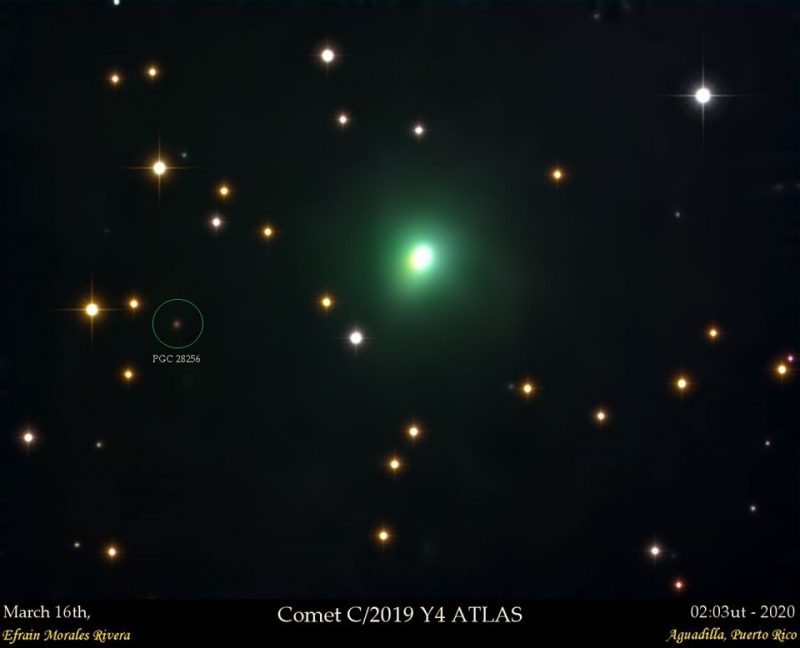
A nice image of Comet C/2019 Y4 (ATLAS) by Efrain Morales from Aguadilla, Puerto Rico. The marked object is a distant galaxy.
A recently discovered comet is getting the attention of astronomers and sky enthusiasts as it’s become brighter than expected in the last few days. Astronomers using the ATLAS (Asteroid Terrestrial-impact Last Alert System) in Hawaii discovered comet C/2019 Y4 (ATLAS) on December 28, 2019. As of mid-late March, it shines at about the brightness of an 8th-magnitude star – not visible to the eye yet – but within reach of medium-sized telescopes in dark skies. The comet is currently crossing Mars’ orbit and is approaching the inner solar system. As it gets closer to us, it’ll get brighter still. We have charts for observers at the bottom of this post.
Comet ATLAS should become bright enough to be easily visible in binoculars, and perhaps bright enough to be seen with the unaided eye from dark sky locations.
Just know that comets are notoriously erratic and inherently unpredictable! We will have to wait to see how Comet Atlas performs.
Astronomer Alessandro Marchini, director of the Astronomical Observatory at the University of Siena in Italy – whose death toll from COVID-19 ramped up dramatically yesterday – sent the video below last night. He wrote:
During this surreal period of the health emergency for the Covid-19, I’m trying to use our social channels to entertain people forced at home. This evening I observed the comet C/2019 Y4 ATLAS during a Facebook Live streaming and here is a time-lapse I made with the images I acquired with our telescope. I hope all is fine with you.
Follow Osservatorio Astronomico Università di Siena on Facebook
Follow Osservatorio Astronomico Università di Siena on YouTube
Thank you, Alessandro, and please stay safe.
Comet C/2019 Y4 (ATLAS) will come closest to Earth on May 23, 2020. Its perihelion or closest approach to the sun will occur on May 31, 2020.
If predictions are correct, Comet ATLAS might reach a visual magnitude of +5 around May 1, 2020. That is theoretically bright enough to be see with the eye, but the fuzziness of faint comets can make them harder to spot than comparably bright stars. When looking for fuzzy objects, it’s best to use averted vision: explanation here.
How bright will the comet get after that? Estimates of Comet ATLAS’s peak brightness range from magnitude +2 to -6 during perihelion or closest approach to the sun, but please know that many comets fizzle and never reach their expected brightnesses. We will have to wait and see.
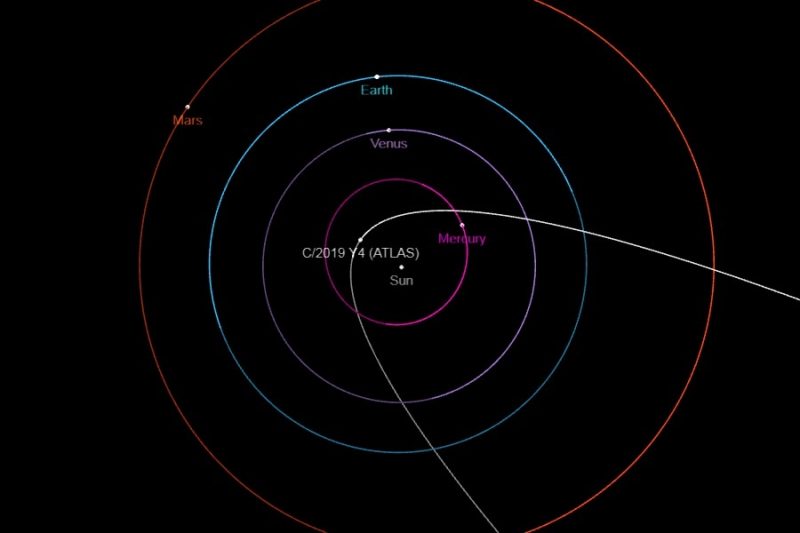
Orbit of comet C/2019 Y4 (ATLAS) Courtesy of NASA/JPL.
How close to our planet will the comet come? The celestial visitor will pass at a huge distance, at some 72,610,769 million miles away (116,855,706 km).
Comet C/2019 Y4 (ATLAS) will pass very close the sun, and thus may disintegrate before becoming bright enough to be seen with the unaided eye.
It will pass at some 23,517,819 miles (37,848,261 km) from the sun, which is closer to our star than Mercury’s elliptical orbit (about 36 million miles or 57.9 million km on average).
Calculations by NASA/JPL indicate comet ATLAS takes some 6,025 years to complete an orbit around the sun. Observations show it has a similar orbit to the Great Comet of 1844, which suggest comet Atlas may be a fragment of the same 1844 comet.
Will Comet C/2019 Y4 (ATLAS) provide a good show or just fizzle out? Let’s keep a close eye on it, just in case! Bookmark this article, as we’ll provide updates and new photos when we can …
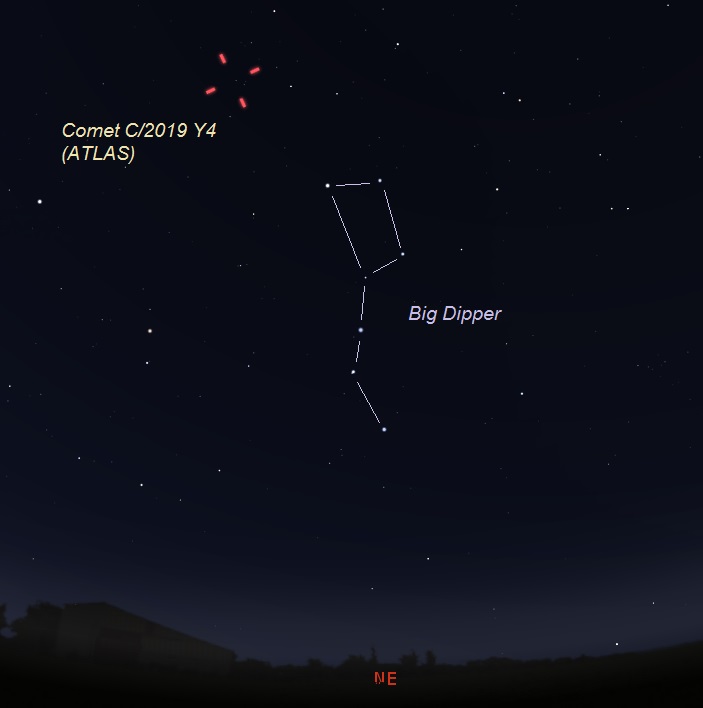
Location of Comet C/2019 Y4 (ATLAS) in late March 2020. This chart faces north-northeast from a temperate latitude in the Northern Hemisphere. The time is around 8:00 p.m. for all locations. In late March, the comet requires a small or medium-sized telescope, but it may be visible in binoculars very soon! Illustration by Eddie Irizarry using Stellarium.
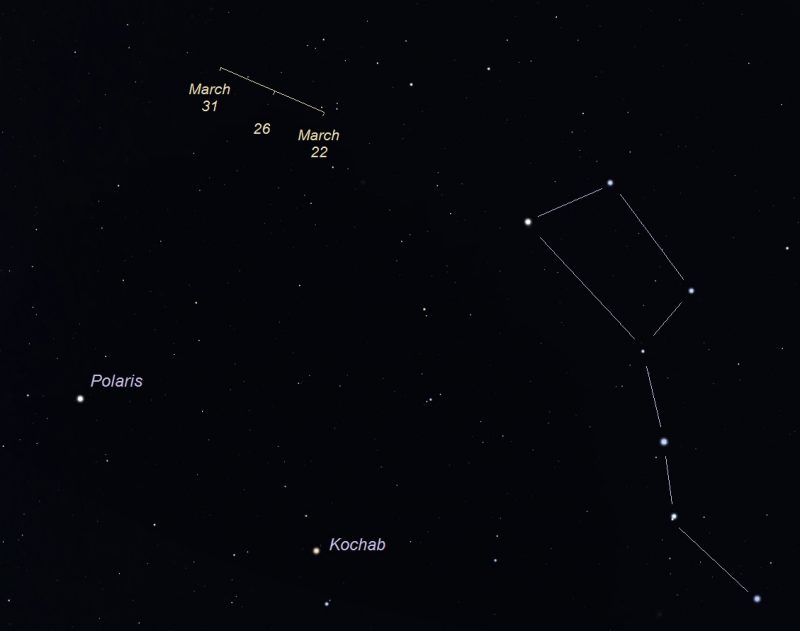
Location of comet C/2019 Y4 (ATLAS) during late March 2020. Facing north-northeast at around 01:00 UTC (8:00 p.m. CDT in the U.S., or around early to mid-evening for all locations). In late March, the comet requires a small or medium-sized telescope, but it may be visible in binoculars very soon! Illustration by Eddie Irizarry using Stellarium.
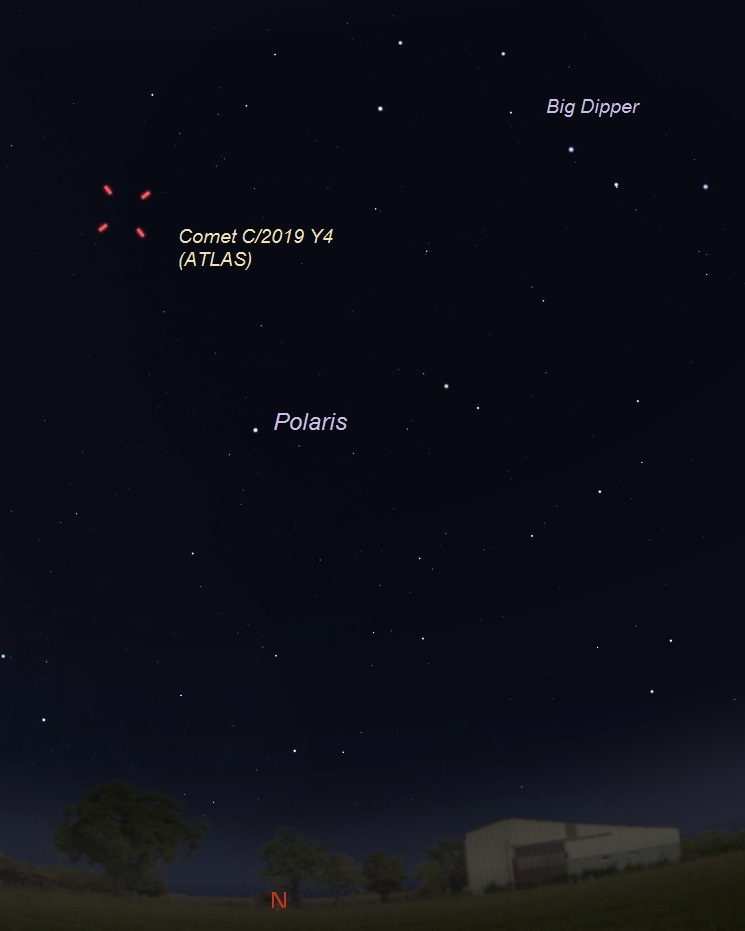
Location of comet C/2019 Y4 (ATLAS) during early April, 2020. Facing north at around 8 p.m. local daylight time (around 7 p.m. if you’re not in daylight time). Illustration by Eddie Irizarry using Stellarium.
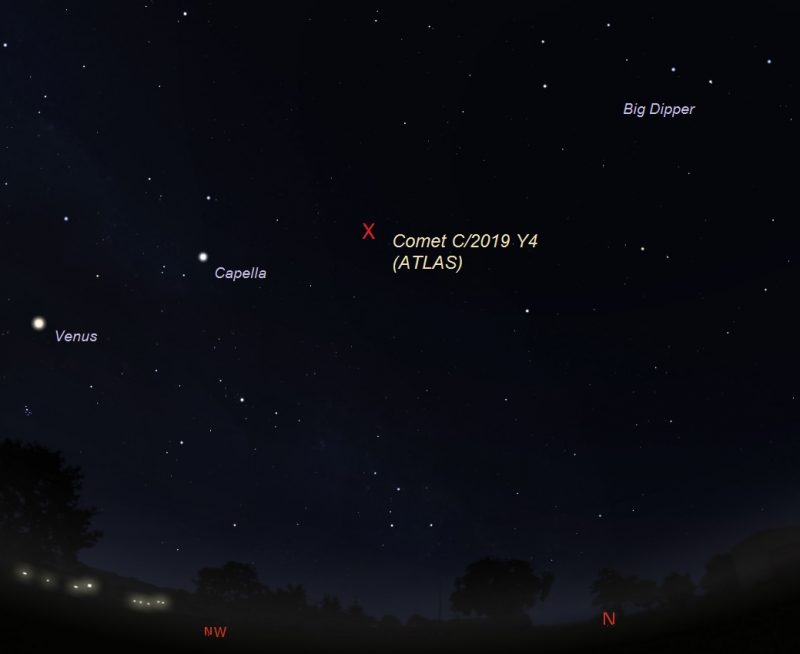
Location of Comet C/2019 Y4 (ATLAS) on April 15, 2020 around 8 p.m. local daylight time (around 7 p.m. if you’re not in daylight time). Illustration by Eddie Irizarry using Stellarium.
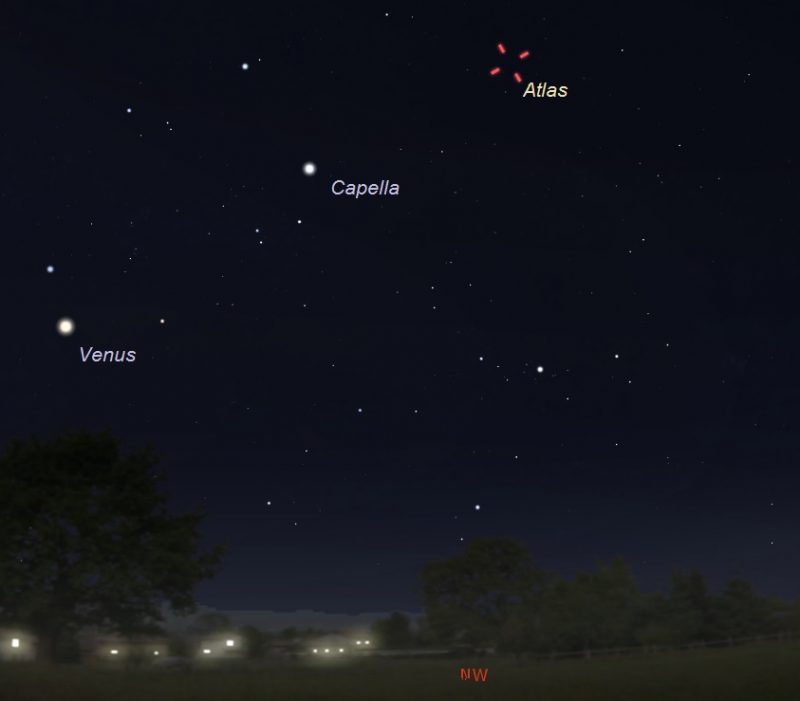
Location of Comet C/2019 Y4 (ATLAS) on April 30, 2020 around 8:30 p.m. local daylight time (around 7:30 p.m. if you’re not in daylight time). Illustration by Eddie Irizarry using Stellarium.
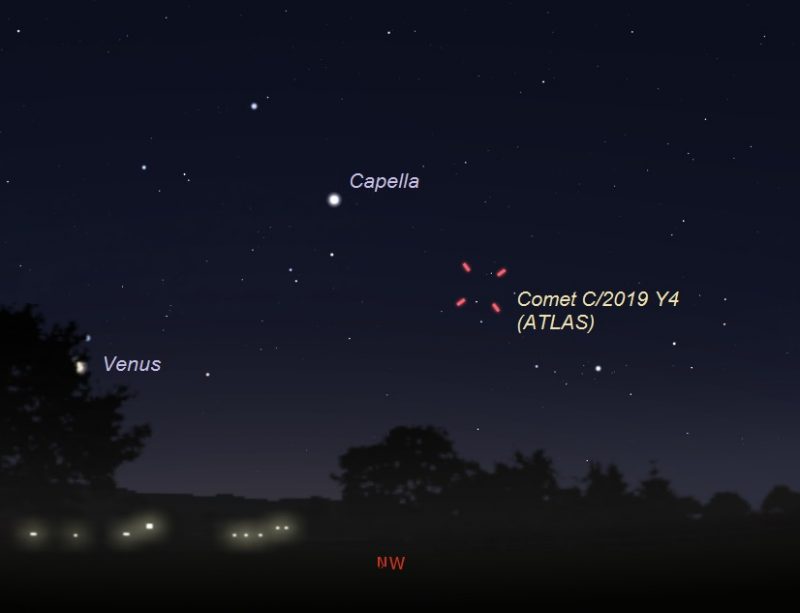
By May 15, 2020 comet C/2019 Y4 (ATLAS) will become increasingly closer to the Northwest horizon. By then it might be bright enough to be easily seen with small binoculars, or perhaps even with the naked eye! Illustration by Eddie Irizarry using Stellarium.
Bottom line: Recently discovered comet C/2019 Y4 (ATLAS) isn’t bright enough to see with the unaided eye … yet. But it’s getting brighter. Will it provide a good show or fizzle out? Click here to learn more.
from EarthSky https://ift.tt/3aenw5a


A nice image of Comet C/2019 Y4 (ATLAS) by Efrain Morales from Aguadilla, Puerto Rico. The marked object is a distant galaxy.
A recently discovered comet is getting the attention of astronomers and sky enthusiasts as it’s become brighter than expected in the last few days. Astronomers using the ATLAS (Asteroid Terrestrial-impact Last Alert System) in Hawaii discovered comet C/2019 Y4 (ATLAS) on December 28, 2019. As of mid-late March, it shines at about the brightness of an 8th-magnitude star – not visible to the eye yet – but within reach of medium-sized telescopes in dark skies. The comet is currently crossing Mars’ orbit and is approaching the inner solar system. As it gets closer to us, it’ll get brighter still. We have charts for observers at the bottom of this post.
Comet ATLAS should become bright enough to be easily visible in binoculars, and perhaps bright enough to be seen with the unaided eye from dark sky locations.
Just know that comets are notoriously erratic and inherently unpredictable! We will have to wait to see how Comet Atlas performs.
Astronomer Alessandro Marchini, director of the Astronomical Observatory at the University of Siena in Italy – whose death toll from COVID-19 ramped up dramatically yesterday – sent the video below last night. He wrote:
During this surreal period of the health emergency for the Covid-19, I’m trying to use our social channels to entertain people forced at home. This evening I observed the comet C/2019 Y4 ATLAS during a Facebook Live streaming and here is a time-lapse I made with the images I acquired with our telescope. I hope all is fine with you.
Follow Osservatorio Astronomico Università di Siena on Facebook
Follow Osservatorio Astronomico Università di Siena on YouTube
Thank you, Alessandro, and please stay safe.
Comet C/2019 Y4 (ATLAS) will come closest to Earth on May 23, 2020. Its perihelion or closest approach to the sun will occur on May 31, 2020.
If predictions are correct, Comet ATLAS might reach a visual magnitude of +5 around May 1, 2020. That is theoretically bright enough to be see with the eye, but the fuzziness of faint comets can make them harder to spot than comparably bright stars. When looking for fuzzy objects, it’s best to use averted vision: explanation here.
How bright will the comet get after that? Estimates of Comet ATLAS’s peak brightness range from magnitude +2 to -6 during perihelion or closest approach to the sun, but please know that many comets fizzle and never reach their expected brightnesses. We will have to wait and see.

Orbit of comet C/2019 Y4 (ATLAS) Courtesy of NASA/JPL.
How close to our planet will the comet come? The celestial visitor will pass at a huge distance, at some 72,610,769 million miles away (116,855,706 km).
Comet C/2019 Y4 (ATLAS) will pass very close the sun, and thus may disintegrate before becoming bright enough to be seen with the unaided eye.
It will pass at some 23,517,819 miles (37,848,261 km) from the sun, which is closer to our star than Mercury’s elliptical orbit (about 36 million miles or 57.9 million km on average).
Calculations by NASA/JPL indicate comet ATLAS takes some 6,025 years to complete an orbit around the sun. Observations show it has a similar orbit to the Great Comet of 1844, which suggest comet Atlas may be a fragment of the same 1844 comet.
Will Comet C/2019 Y4 (ATLAS) provide a good show or just fizzle out? Let’s keep a close eye on it, just in case! Bookmark this article, as we’ll provide updates and new photos when we can …

Location of Comet C/2019 Y4 (ATLAS) in late March 2020. This chart faces north-northeast from a temperate latitude in the Northern Hemisphere. The time is around 8:00 p.m. for all locations. In late March, the comet requires a small or medium-sized telescope, but it may be visible in binoculars very soon! Illustration by Eddie Irizarry using Stellarium.

Location of comet C/2019 Y4 (ATLAS) during late March 2020. Facing north-northeast at around 01:00 UTC (8:00 p.m. CDT in the U.S., or around early to mid-evening for all locations). In late March, the comet requires a small or medium-sized telescope, but it may be visible in binoculars very soon! Illustration by Eddie Irizarry using Stellarium.

Location of comet C/2019 Y4 (ATLAS) during early April, 2020. Facing north at around 8 p.m. local daylight time (around 7 p.m. if you’re not in daylight time). Illustration by Eddie Irizarry using Stellarium.

Location of Comet C/2019 Y4 (ATLAS) on April 15, 2020 around 8 p.m. local daylight time (around 7 p.m. if you’re not in daylight time). Illustration by Eddie Irizarry using Stellarium.

Location of Comet C/2019 Y4 (ATLAS) on April 30, 2020 around 8:30 p.m. local daylight time (around 7:30 p.m. if you’re not in daylight time). Illustration by Eddie Irizarry using Stellarium.

By May 15, 2020 comet C/2019 Y4 (ATLAS) will become increasingly closer to the Northwest horizon. By then it might be bright enough to be easily seen with small binoculars, or perhaps even with the naked eye! Illustration by Eddie Irizarry using Stellarium.
Bottom line: Recently discovered comet C/2019 Y4 (ATLAS) isn’t bright enough to see with the unaided eye … yet. But it’s getting brighter. Will it provide a good show or fizzle out? Click here to learn more.
from EarthSky https://ift.tt/3aenw5a

Aucun commentaire:
Enregistrer un commentaire